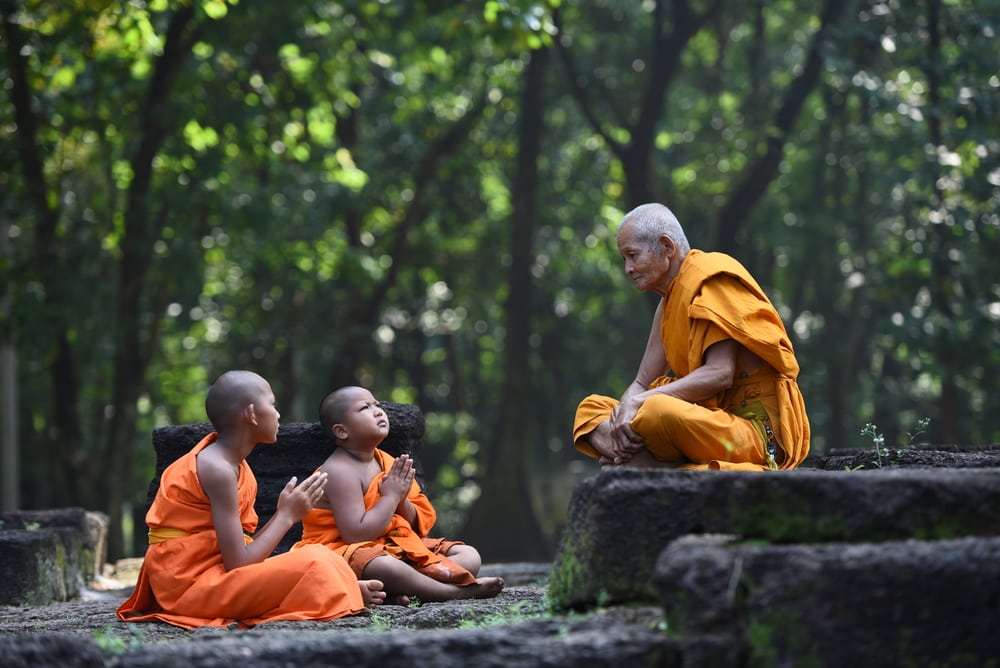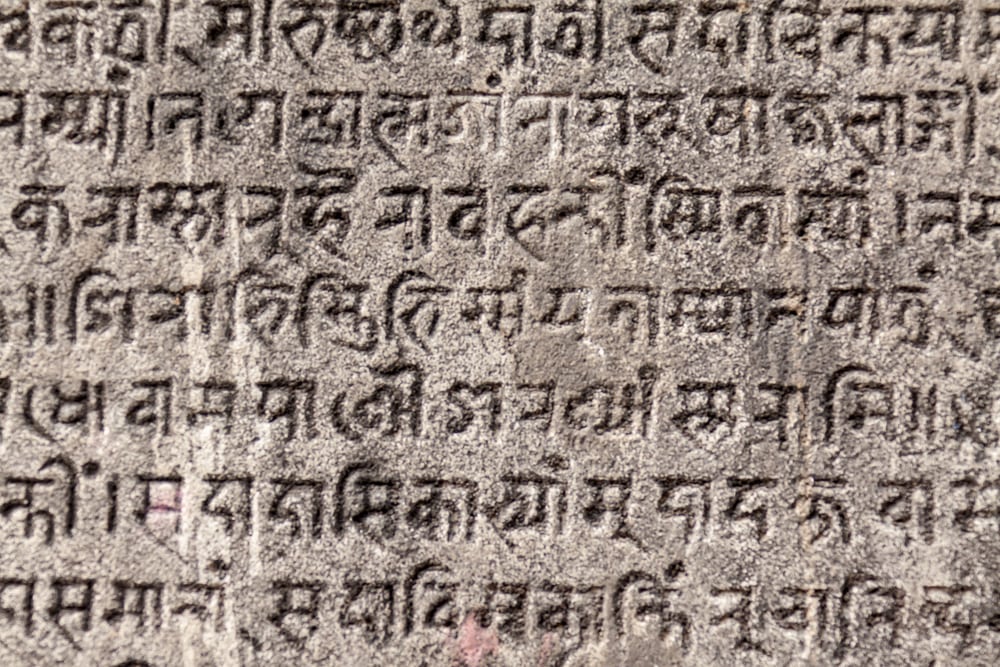

In this lesson, we explore the historical context surrounding the Yoga Sutras of Patanjali.
Objective
Gain a basic understanding of the historical context of the Yoga Sutras of Patanjali and build a foundation for exploring the teachings.
Description
Learn about the authorship of the Yoga Sutras and the meaning and use of the sutra style. Consider why Sanskrit is well-suited for communicating these teachings and an issue related to translating the text into English. Examine the branch of yoga from which the Yoga Sutras arise and how the teachings compare to Buddhist philosophy
Vocabulary
Patanjali, Sanskrit, sutra

Why the Dates are Unknown
The dates proposed for Patañjali’s birth and life vary by a millennium… A part of the reason for this wide divergence in possible dates is the tradition, common at the time… In order to make their contributions more acceptable, and to give them some cachet and an air of authority, later thinkers were frequently content to concede authorship of their contributions to one or another of their more illustrious predecessors. Those predecessors thus acquired an exaggerated longevity… Given that the knowledge in Patañjali’s most widely recognized work, the Yoga Sutras, is presented through a series of terse aphorisms, a date for him of somewhere between the fourth and second centuries BCE becomes highly likely… Give or take a century, therefore, somewhere around 250 BCE seems the best bet. – Kofi Busia, Patanjali Biography link
Patanjali’s Role
Patanjali, the author of the Yoga Sutras, lived somewhere between 500 BCE and 200 CE, a time that possibly overlaps the life of Buddha and a period of intense philosophical activity in India. Patanjali was revered as an outstanding scholar and wise man who wrote significant commentaries on Sanskrit grammar and Ayurveda… The Patanjali yoga tradition is a later expression of older teachings based on the source texts of India known as the Vedas. – Nicolai Bachman, The Path of the Yoga Sutras 2011 p 1 link
A Yogi Writing for His Contemporaries, Not for General Public
Not much is known of Patanjali… There are many differing options about who he was and when exactly he lived… Whatever the truth of the matter, it seems evident to us that Patanjali was a practicing yogi writing for his contemporary community of yoga practitioners and students. The Sutras do not impart philosophy in a vacuum, nor are they intended for intellectual dabblers or the general public. – Alan Finger & Wendy Newton, Tantra of the Yoga Sutras 2018 p 1 link
Patanjali, the Man
Master Patanjali was a great yogi; he knew the physical poses of yoga and the art of breathing: yoga of the body. He was also a great thinker and meditator—a master of the yoga of the mind. He wrote as well famous books on medicine and on Sanskrit, the ancient tongue from which almost all our languages come. He is recognized, too, as the father of the classical dance of India. – Geshe Michael Roach & Christie McNally, The Essential Yoga Sutra 2005 p 1 link
Patanjali’s Approach
Sri Patanjali was the epitome of acceptance of all methods and of broad-mindedness of approach. He did not limit his instructions to one particular technique, to members of any particular religion, philosophy, or in any other way. He gave general principles and used specifics only as examples. – Sri Swami Satchidananda, The Yoga Sutras of Patanjali 2009 p xiv link

Lots of Sutras
For millennia the teachings on transformation and awakening were taught face-to-face… Here are some of the famous sutras: The Yoga Sutras, The Kama Sutras, The Shiva Sutras . . . There are lots and lots of sutras. – Eric Klein, Wisdom Heart, What is a Sutra?
The Finest Example
Patañjali’s work is widely regarded as the finest example extant of the sutra method of presentation. – Kofi Busia, Patanjali Biography link
Inspiration for the Teacher
Sutras are not intended to be instruction for the student, but inspiration for the teacher. – Leslie Kaminoff
Discovering the Hidden “Thread”
The most important characteristics of this method are utmost condensation consistent with clear exposition of all essential aspects and continuity of the underlying theme in spite of the apparent discontinuity of the ideas presented. The latter characteristic is worth noting because the effort to discover the hidden “thread” of reasoning beneath the apparently unconnected ideas very often provides the clue to the meaning of many Sutras. It should be remembered that this method of exposition was prevalent at a time when printing was unknown and most of the important treatises had to be memorized by the student. Hence the necessity of condensation to the utmost limit. Nothing essential was, of course, left out but everything with which the student was expected to be familiar or which he could easily infer from the context was ruthlessly cut out. – I. K. Taimni, The Science of Yoga 2007 pgs 3-4 link
Brevity & Clarity
The text is a masterpiece of brevity and clarity. Patanjali has removed all unnecessary words for the following reasons: 1) To allow easy memorization by disciples; remember there were no printing presses at the time. 2) To allow the verses to be the object of inquiry; too many words would confuse. 3) To prevent misquotation and misinterpretation. The verses are sheer poetry combined with sublime scientific precision. – Swami Satyananda Saraswati, Four Chapters on Freedom 2008 p 6 link
They Can Be Related to Our Situation
The Yoga Sutras as they were written allow us to question and interpret them, and relate them to our particular situation and life. – Nischala Joy Devi, The Secret Power of Yoga 2007 pgs xxi-xxiv link
Teaching Brings the Sutras to Life
Patanjali’s Yoga Sutra is the heart of yoga. The heart, hrdaya, is that which does not change and Patanjali gave a permanent definition and form to yoga in his Sutra. The heart without prana, however, is not alive and is without relevance for us. Desikachar explains that the teaching relationship is the prana or life of the Yoga Sutra; it is the teacher who brings the heart into life. The Yoga Sutra is a potent tool for the teacher who is able to make it relevant to the student and thus transmit the transformative power of the heart. – Mark Whitwell from TKV Desikachar’s The Heart of Yoga 1995 pg 145 link

Designed to Express the Subtle Aspects of Yoga
The aphorisms are written in Sanskrit, a language designed to express the subtle aspects of yoga. – Nicolai Bachman, The Path of the Yoga Sutras 2011 p 2 link
Many Subtleties May Be Lost in Translation
Sanskrit, the language of the sutras, is particularly well suited to this heart-centered approach because it is a vibrational language, one in which words resonate through countless layers of meaning. When this powerful vibrational language is translated literally into a very logical and straightforward language like English, many of its subtleties may be lost. The strength of the English language lies in precise, concrete explanations. It is less powerful when describing the subtler realms, the unity of the feminine and the masculine, and especially the intuitive realm. – Nischala Joy Devi, The Secret Power of Yoga 2007 p xxv link

Resurfaced After 700 Years Thanks to Swami Vivekananda
The Yoga Sutras of Patanjali date from the first half of the 1st millennium CE, but only gained prominence in the West in the 20th century. The text fell into obscurity for nearly 700 years from the 12th to 19th century then resurfaced late 19th century due to the efforts of Swami Vivekananda. – Mark Giubarelli, The History of Yoga link
Violent, Crushing Annihilation
The British attempted to wipe out Ayurveda in India during colonial rule. “Officers would chop off three fingers on Ayurvedic doctors, so they couldn’t do pulse diagnosis and, after the British left India, Ayurveda was nearly wiped out,” claims Will. – Anita Bhagwandas link
Resilient People Preserved Yoga Despite Efforts to Eradicate It
The British used violence, rape, and murder to take control of the South Asian sub-continent — and they approached yoga with violence, too. They forced people to convert to Christianity, and outlawed the healing and spiritual practices seen as “primitive” traditions, like yoga. So how did South Asian people preserve yoga through all of that? With incredible resilience — and also by taking huge risks, with many of them losing their land and their lives. With yoga being so popular these days, it’s hard to imagine having to go through all of that just to practice it. – Maisha Z. Johnson link

Buddhist Philosophy & Yoga Sutras “Almost Identical”
I was interested to discover that the Yoga Sutras, while organized somewhat differently, are almost identical to the Buddhist philosophy I’d been reading for so many years. – Charlotte Bell, Mindful Yoga, Mindful Life 2007 p 110 link
Resemblance to Buddhist Philosophy
Any person with some knowledge of Buddhism can clearly see close resemblances between the teachings of Buddha and Patanjali, especially in such basic rules as yama and niyama and in the basic philosophical concepts but whether the Yoga Sutras came before or after Buddha is not certain. – Swami Satyananda Saraswati, Four Chapters on Freedom 2008 p 9 link
Yogic & Buddhist Thinkers Influenced One Another
We find within the text of the Yoga Sutra many, many terms that are uncommon within the yoga tradition yet which work well when cross-referenced with Buddhism. This… is very interesting because it is a demonstration of how the thinkers within the yogic and Buddhist systems were in contact with and were influencing one another. – Richard Freeman, The Mirror of Yoga 2010 pgs 149-150 link

We hope you found this brief excerpt from our Member site useful and inspiring.
In this way, we make every yoga teaching subject accessible, building on a foundation of knowledge that allows you to go deeper while retaining and applying what you learn.
The Philosophy section on the Member site is extensive and includes such lessons as:
- Studying & Teaching Philosophy
- What is Yoga?
- Philosophies
- Branches of Yoga
- Sanskrit
- The Yoga Sutras Context
- The Yoga Sutras Book One
- The Yoga Sutras Book Two
- The Yoga Sutras Book Three
- The Yoga Sutras Book Four
- The Eight Limbs of Yoga Intro
- Yamas & Niyamas
- Asana
- Pranayama
- Pratyahara
- Dharana
- Dhyana
- Samadhi
- Kleshas
- Kriya Yoga
- Energy & The Subtle Body
- Prana Vayus
- Chakras: an overview plus deep, organized information on each chakra
- Koshas
- The Bhagavad Gita
- Mythology